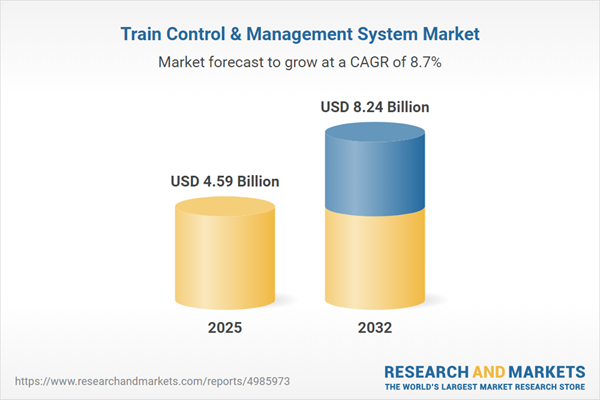Speak directly to the analyst to clarify any post sales queries you may have.
Train control and management systems are central to modernizing rail networks, delivering enhanced automation, safety, and operational visibility for infrastructure owners and operators. As rail networks face demands for increased efficiency, resilience, and technological integration, strategic investments in these solutions are shaping the next era of mobility.
Market Snapshot: Train Control & Management System Market
The Train Control & Management System Market grew from USD 4.23 billion in 2024 to USD 4.59 billion in 2025. It is forecast to expand at a CAGR of 8.70%, reaching USD 8.24 billion by 2032.
Scope & Segmentation of the Train Control & Management System Market
This report delivers comprehensive analysis by segmenting the market across critical dimensions to enable precise decision-making for stakeholders:
- Component Types: Automatic Train Operation, Automatic Train Protection, Automatic Train Supervision, Interlocking System
- Service Offerings: Installation and Integration, Maintenance and Support, Modernization and Upgrades
- Communication Technologies: GSM-R, LTE, Optical Fiber
- Application Segments: Freight, High Speed, Main Line, Urban Transit
- Regional Analysis: Americas (North America: United States, Canada, Mexico; Latin America: Brazil, Argentina, Chile, Colombia, Peru), Europe, Middle East & Africa (Europe: United Kingdom, Germany, France, Russia, Italy, Spain, Netherlands, Sweden, Poland, Switzerland; Middle East: United Arab Emirates, Saudi Arabia, Qatar, Turkey, Israel; Africa: South Africa, Nigeria, Egypt, Kenya), Asia-Pacific (China, India, Japan, Australia, South Korea, Indonesia, Thailand, Malaysia, Singapore, Taiwan)
- Key Companies Analyzed: Siemens Mobility GmbH, Alstom SA, CRRC Corporation Limited, Wabtec Corporation, Hitachi Rail STS S.p.A., Thales SA, Knorr-Bremse AG, Mitsubishi Electric Corporation, Construcciones y Auxiliar de Ferrocarriles, S.A., Stadler Rail AG
Key Takeaways for Senior Decision-Makers
- Market expansion is driven by growing automation, real-time analytics, and integration of digital communication in rail operations.
- System upgrades focus on modular and interoperable platforms, minimizing disruption and adapting to evolving regulatory and operational requirements.
- Advanced safety and analytics modules support condition-based maintenance, improving performance and lifecycle management of assets.
- Regional growth varies with the Americas investing in signaling modernization, Europe prioritizing cross-border standardization, and Asia-Pacific capitalizing on rapid urbanization and government-led smart city initiatives.
- Collaboration between operators, technology vendors, and infrastructure owners fosters innovation, accelerates deployment cycles, and aligns technology roadmaps with targeted performance outcomes.
- Operators are mitigating supply disruptions through diversification of sourcing strategies and long-term supplier partnerships.
Tariff Impact on Train Control Solution Supply Chains
The 2025 introduction of United States tariffs on key electronic and communication components has led to increased input costs for train control solution providers. This has resulted in suppliers diversifying production hubs, adjusting procurement strategies, and stockpiling critical spares to manage risk. Integration partners now face extended lead times, making flexible contracting and software-driven upgrades more appealing to sustain project timelines and margins.
Methodology & Data Sources
Findings are based on a multi-phase research methodology combining in-depth executive interviews, field visits, vendor briefings, and secondary research from technical standards, regulatory filings, and proprietary databases. Analytical frameworks such as SWOT and Porter’s Five Forces reinforce the objectivity and rigor of the market insights.
Why This Report Matters
- Actionable insights help operators and vendors refine procurement, technology, and partnership strategies for sustainable competitive advantage.
- Granular segmentation and regional analysis enable targeted investment planning and risk management in diverse rail environments.
- Up-to-date evaluation of regulatory, technological, and supply chain trends equips stakeholders to anticipate and navigate disruptive market forces.
Conclusion
Advancements in train control and management systems are pivotal for future-ready rail operations. Adopting modular, interoperable solutions and robust supply strategies will position market participants to capitalize on evolving opportunities and strengthen network performance.
Additional Product Information:
- Purchase of this report includes 1 year online access with quarterly updates.
- This report can be updated on request. Please contact our Customer Experience team using the Ask a Question widget on our website.
Table of Contents
3. Executive Summary
4. Market Overview
7. Cumulative Impact of Artificial Intelligence 2025
Companies Mentioned
The companies profiled in this Train Control & Management System market report include:- Siemens Mobility GmbH
- Alstom SA
- CRRC Corporation Limited
- Wabtec Corporation
- Hitachi Rail STS S.p.A.
- Thales SA
- Knorr-Bremse AG
- Mitsubishi Electric Corporation
- Construcciones y Auxiliar de Ferrocarriles, S.A.
- Stadler Rail AG
Table Information
| Report Attribute | Details |
|---|---|
| No. of Pages | 186 |
| Published | October 2025 |
| Forecast Period | 2025 - 2032 |
| Estimated Market Value ( USD | $ 4.59 Billion |
| Forecasted Market Value ( USD | $ 8.24 Billion |
| Compound Annual Growth Rate | 8.7% |
| Regions Covered | Global |
| No. of Companies Mentioned | 11 |









